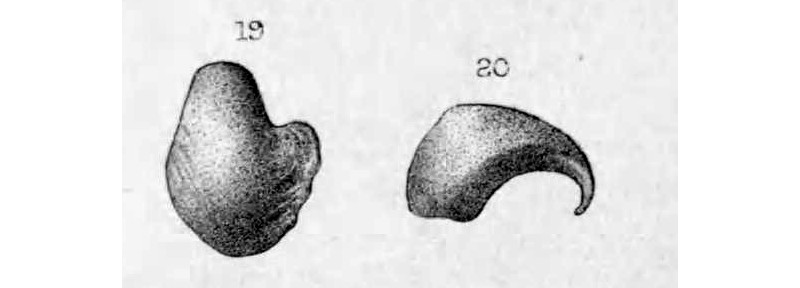Deltodus gibbus
Woodward, 1889
Classification: Holocephali Cochliodontiformes Cochliodontidae
Reference of the original description
Catalogue of the fossil fishes in the British Museum. Part. I. British Museum (Natural History): 474 p., fig., 17 pl.
Catalogue of the fossil fishes in the British Museum. Part. I. British Museum (Natural History): 474 p., fig., 17 pl.
Description:
Citation: Deltodus gibbus Woodward, 1889: In: Database of fossil elasmobranch teeth www.shark-references.com, World Wide Web electronic publication, Version 01/2026
Please send your images of "Deltodus gibbus" to info@shark-references.com

Deltodus gibbus sp. nov.; “lower” dental plate, coronal aspect, Carbfs. Limst. ; Bristol [20575 b.], 20. Ditto ; “lower” dental plate, antero-lateral aspect, [P.5859.]

Deltodus gibbus sp. nov.; “lower” dental plate, coronal aspect, Carbfs. Limst. ; Bristol [20575 b.], 20. Ditto ; “lower” dental plate, antero-lateral aspect, [P.5859.]
Description
Original description of Woodward, 1889 [2593]:
Type. “Lower” dental plates, shown in PI. VI. figs. 19, 20. A comparatively small species, the maximum transverse measurement of the supposed lower posterior dental plate being about 0‘014. Anterior coronal elevation ex-tending from the outer to the inner margin, broad, rounded, but having a hump-backed ap-pearance when worn, gradually passing into the narrow postero-lateral flattened portion of the plate, and immediately adjoining the antero-lateral margin; inner margin strongly curved throughout the greater portion of its length, the rounded elevation projecting. Transverse ridges and furrows of the dental crown narrow, feebly marked. The opposing dental plates of this species are not yet certainly recognizable; it seems likely that they are confounded with the supposed upper dental plates of Deltoptychius gibberulus.
Form. & Loc. Lower Car-boniferous Limestone: Bristol.
20575 b, P. 5859. Type specimens, readily distinguished from the corresponding dental plates of D. sublaevis by their narrowness and the prominence, obliquity, and sharply-bent worn surface of the rounded coronal elevation.
Original description of Woodward, 1889 [2593]:
Type. “Lower” dental plates, shown in PI. VI. figs. 19, 20. A comparatively small species, the maximum transverse measurement of the supposed lower posterior dental plate being about 0‘014. Anterior coronal elevation ex-tending from the outer to the inner margin, broad, rounded, but having a hump-backed ap-pearance when worn, gradually passing into the narrow postero-lateral flattened portion of the plate, and immediately adjoining the antero-lateral margin; inner margin strongly curved throughout the greater portion of its length, the rounded elevation projecting. Transverse ridges and furrows of the dental crown narrow, feebly marked. The opposing dental plates of this species are not yet certainly recognizable; it seems likely that they are confounded with the supposed upper dental plates of Deltoptychius gibberulus.
Form. & Loc. Lower Car-boniferous Limestone: Bristol.
20575 b, P. 5859. Type specimens, readily distinguished from the corresponding dental plates of D. sublaevis by their narrowness and the prominence, obliquity, and sharply-bent worn surface of the rounded coronal elevation.
References
Rise and diversification of chondrichthyans in the Paleozoic. Paleobiology, 50(2), 271–284
DOI: 10.1017/pab.2024.1

Catalogue of the fossil fishes in the British Museum. Part. I. British Museum (Natural History): 474 p., fig., 17 pl.
Rise and diversification of chondrichthyans in the Paleozoic. Paleobiology, 50(2), 271–284
DOI: 10.1017/pab.2024.1

Catalogue of the fossil fishes in the British Museum. Part. I. British Museum (Natural History): 474 p., fig., 17 pl.


















